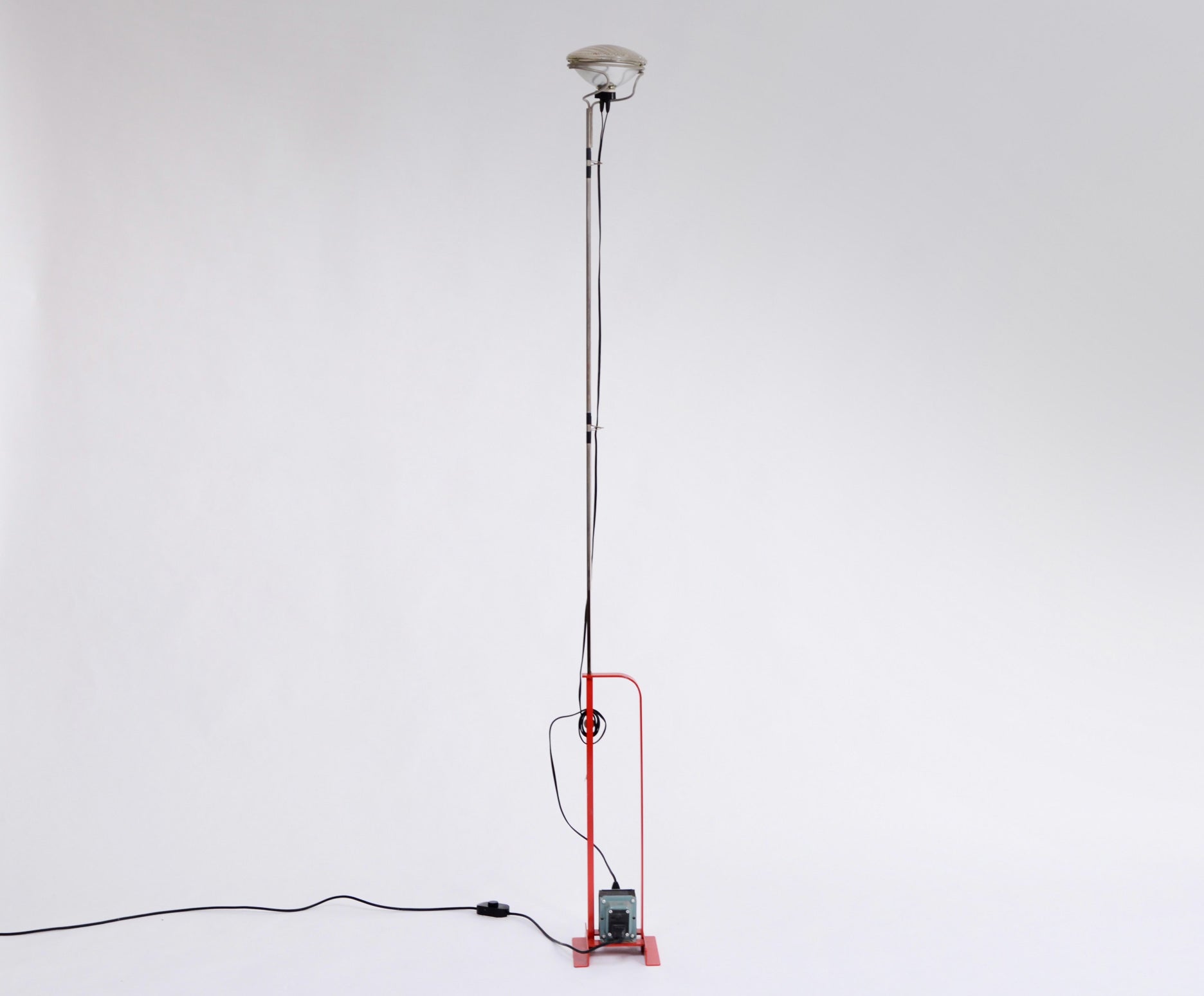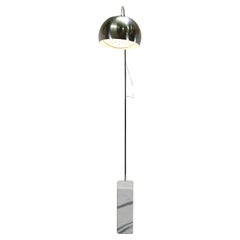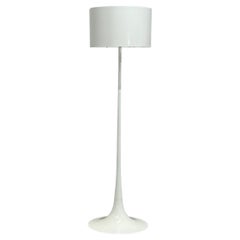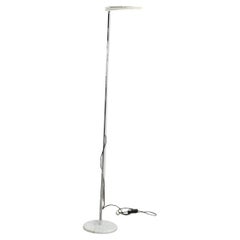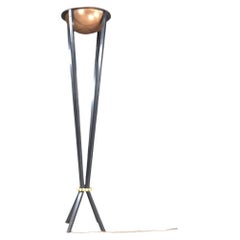Flos Toio LED Red by Achilles And Piergiacomo Castiglioni Floor Lamp
About the Item
- Creator:Flos (Manufacturer),Achille Castiglioni (Designer),Pier Giacomo Castiglioni (Designer),Achille & Pier Giacomo Castiglioni (Designer)
- Design:
- Dimensions:Height: 76.5 in (194.3 cm)Width: 8.27 in (21 cm)Depth: 8.27 in (21 cm)
- Power Source:Plug-in
- Voltage:220-240v
- Lampshade:Not Included
- Materials and Techniques:
- Place of Origin:
- Period:
- Date of Manufacture:2010s
- Condition:Wear consistent with age and use. slight rusting and chips to the base.
- Seller Location:Basildon, GB
- Reference Number:Seller: L000281stDibs: LU4510239500932
Toio Floor Lamp
The idea of the readymade didn’t just upend the art world, it also provoked a wave of invention in design. This provocative spirit is alive and well in the Toio floor lamp, which sees an integration of automotive parts as well as everyday recreational gear.
Along with their eldest brother, Livio, Pier Giacomo (1913–68) and Achille (1918–2002) Castiglioni were born in Milan and for a time, the three worked together in their own firm as architects and designers. While Livio departed the practice in 1952, Pier Giacomo and Achille would continue to collaborate on a wealth of projects in the ensuing years. The pair shared an experimental nature and injected personality and wit into the wide range of their celebrated mid-century modern designs, such as the Arco lamp, the Snoopy lamp and lots more.
Inspired by Marcel Duchamp, the brothers often used found objects in their designs, notably in the Mezzadro Tractor stool, the Super Sella stool and the Toio floor lamp. Produced by FLOS in 1962, the Toio (“toy”) incorporates a car headlamp and elements of a fishing pole. The height of the headlamp, which always faces up to provide indirect light, is adjustable, while fishing-rod rings at intervals along the stem help guide the electrical cord. At the base, a mechanism similar to the cleats on a boat keeps the cord neatly coiled and tucked away from view. These inventive utilitarian touches earned the fixture a coveted spot in MoMA’s permanent collection. Unusual and delightful in equal amounts, the Toio floor lamp is still manufactured by FLOS and reminds us that humor is a potent element of design.
Achille Castiglioni
Milanese designer and architect Achille Castiglioni sought to inject personality into all of his work, and found deep inspiration in everyday objects. A legend of Italian mid-century modernism, he created iconic, universally loved table lamps, chairs and other lighting and furniture with his likeminded brothers during the postwar years.
There was the Snoopy lamp, which brings to mind the unmistakable Peanuts character, while the shape of a common street lamp inspired the design behind the Arco floor lamp. Elsewhere, the Toio floor lamp — a provocative fixture in any living room — was made with automotive parts as well as run-of-the-mill recreational gear.
Castiglioni studied the classics at Liceo Classico Giuseppe Parini, art at the Accademia di Belle Arti di Brera and finally architecture and design at the Polytechnic University of Milan. After graduating in 1944, Castiglioni began working with his brothers Pier Giacomo and Livio at the studio they cofounded with classmate Luigi Caccia Dominioni.
Livio left to pursue lighting design and sound technology, leaving Achille and Pier Giacomo to continue to collaborate on various projects. One such design was the iconic Taraxacum hanging lamp for FLOS which featured a resin “cocoon” created with sprayed plastic polymers that protects its steel core and allows for the diffusion of light.
Castiglioni won Italy’s highest award for industrial design — the Compasso d’Oro — seven times, and the Museum of Modern Art was home to his first individual retrospective in the United States. Castiglioni later taught at the Polytechnic University of Turin and at Polytechnic in Milan.
Castiglioni’s designs remain timeless. Some of them can be found in Tokyo’s Living Design Center Ozone, the Triennale di Milano and the Hangaram Art Museum at the Seoul Arts Center.
Find vintage Achille Castiglioni lighting, seating, tables and other furniture on 1stDibs.
You May Also Like
Vintage 1960s Italian Modern Floor Lamps
Metal
Vintage 1960s Italian Mid-Century Modern Floor Lamps
Metal, Aluminum
Vintage 1970s Italian Modern Floor Lamps
Metal
Vintage 1960s Italian Mid-Century Modern Floor Lamps
Brass, Steel
21st Century and Contemporary Italian Modern Floor Lamps
Stainless Steel
Vintage 1960s Italian Mid-Century Modern Floor Lamps
Steel, Stainless Steel
Vintage 1960s Italian Mid-Century Modern Floor Lamps
Marble, Metal, Steel
21st Century and Contemporary Italian Modern Floor Lamps
Stainless Steel
21st Century and Contemporary Italian Modern Floor Lamps
Stainless Steel
Vintage 1960s Italian Mid-Century Modern Floor Lamps
Carrara Marble, Steel
More From This Seller
View All21st Century and Contemporary Italian Minimalist Floor Lamps
Marble, Aluminum
21st Century and Contemporary Italian Modern Floor Lamps
Metal
Late 20th Century Italian Modern Floor Lamps
Marble, Metal
21st Century and Contemporary British Modern Floor Lamps
Metal
21st Century and Contemporary British Modern Floor Lamps
Metal
1990s Italian Table Lamps
Aluminum
Recently Viewed
View AllRead More
We Dare You Not to Smile at These Whimsical Italian Designs
Make anyplace your happy place with Italian furniture at its subversive best.
Rooms We Love: 11 Splendid Living Rooms
Common wisdom used to declare the kitchen the hub of the house. These days, the living room seems to have assumed the role of domestic focal point. Unlike the Victorian parlor, stiffly furnished and reserved for guests, today’s living room is a central place for reading, conversation and, well, living, with furnishings that lend themselves to both casual lounging and elegant entertaining.
